Ikebana: what is it, history and rules of creation
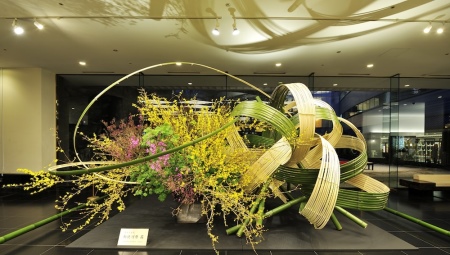
The art of ikebana came to us from Japan, although many believe that it originated in India and China, and only then came to Japan. This intricate word refers to the ability to form unique, original, spectacular compositions that are capable of expressing human emotions.
Ikebana masters combine unusual materials, flowers, branches of strange shapes. Gradually, art moved away from religiosity and began to embody not only gifts in temples, but also graceful bouquets in secular life. Ikebana has had a huge impact on floristry, thanks to its principles, many flower arrangements are made.
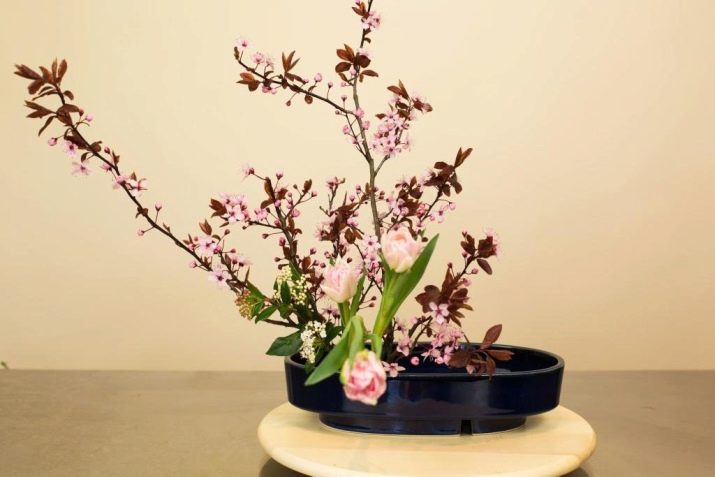
What it is?
Floral art from Japan literally translates as a composition of fresh flowers. It was in Japan that ikebana gained real popularity, and it was from there that it spread throughout the world. The history of the creation of bouquets began in the 15th century, when monks created flower bouquets as a gift to the gods in temples. Gifts for Japanese gods formed according to the principle of moderation, elegance, naturalness.
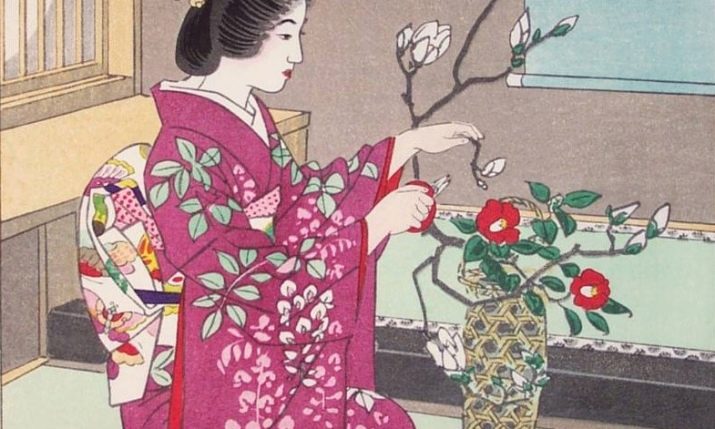
Ikebana has proven that it is completely unnecessary to combine a variety of colors, varieties and intricate decor to create an expressive and effective bouquet.
A bud, petal, branch is enough for a real master to create a masterpiece from them, reflect the beauty of natural nature and put meaning. The ikebana master not only creates bouquets, he reflects his inner state, shows the beauty of the soul, worldview, the infinity of space. The flower is not only the basis of the composition, it is also a symbol of eternal life.
There is a legend that says how the art of fresh flowers originated. Once upon a time, a tornado of unprecedented power destroyed a huge amount of flora in Japan. After that, the monks walked around the distorted gardens, collected fragments of plants and flowers. With this amazing gift, they turned to the gods with a prayer inquiring about the restoration of the ravaged gardens. The Buddha heard them, and in a moment the gardens became lush and luxurious again, like before a hurricane. This was the beginning of flower offerings, in each of which the monks tried to put a request, appeal, gratitude.
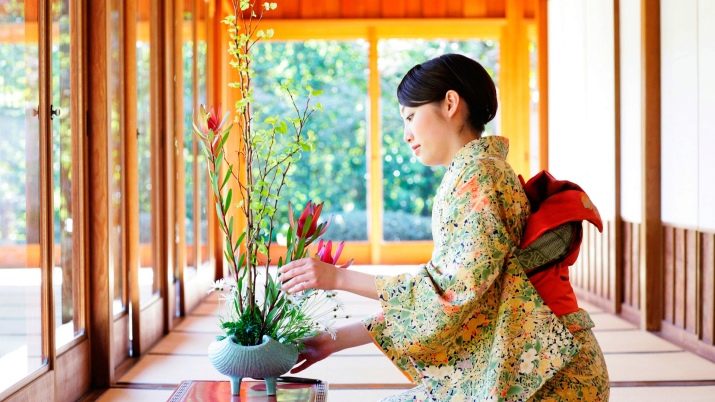
Experts identify a number of features that make ikebana different from standard floristry:
- not only aesthetic, but also semantic expressiveness, reflecting the thoughts, mood, ideas of the person who composes it;
- absolutely logical relationship between all parts of the composition;
- volume, thanks to which the effectiveness of the composition can be assessed from any point of view;
- a high-quality balance, a well-thought-out color palette, the ratio of colors, their placement, the harmony of light and dark, small and large so that the composition looks holistic;
- competent accentuation, most often one non-standard object plays the role of an accent - an exotic plant, a bizarrely curved branch - around which the rest of the elements are tactfully located, emphasizing the expressiveness of the accent;
- the harmony of the base, that is, the correct choice of the vessel is considered very important - it can be a background, a stand, a bowl, but they must be included in the overall composition, be organic with it.
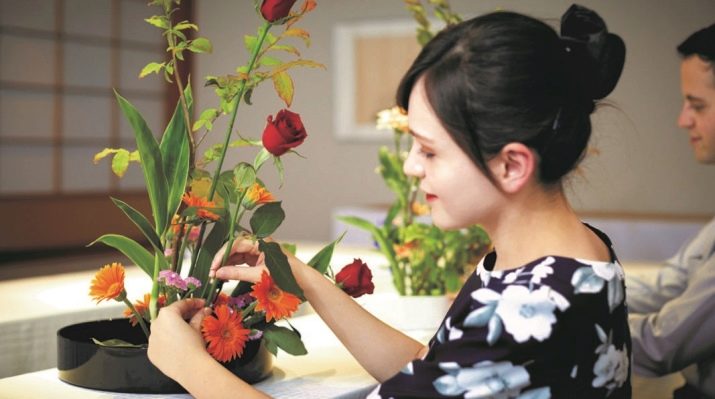
The Japanese consider ikebana-style compositions an art, they teach it for a long time and painstakingly. It is impossible to master the art of playing the violin in one lesson, as floristry requires constant and tireless studies, self-improvement.
It is very important to have a taste, to feel harmony, to be able to see the plot and express your ideas correctly. Ikebana are made in various styles, in addition, they are created by the type of placement: on the table, on the wall. Factors such as line, shape, color play a huge role in this art.
The vertical line reflects, first of all, flight, joyful emotions, a rise in mood. Horizontal - calmness to indifference, detached attitude, melancholy. The concept of color is also capable of expressing a lot, for example, shades of the warm spectrum - yellow, orange - symbolize a joyful mood and positive, peacefulness, disposition towards others. Cold scale - blue, light blue, gray - expresses calmness, restraint.
There are neutral palettes, such as greens, that combine all other tonalities into a single plot. The master knows how to play with shades and contrasts in order to express his emotions and awaken them in others.
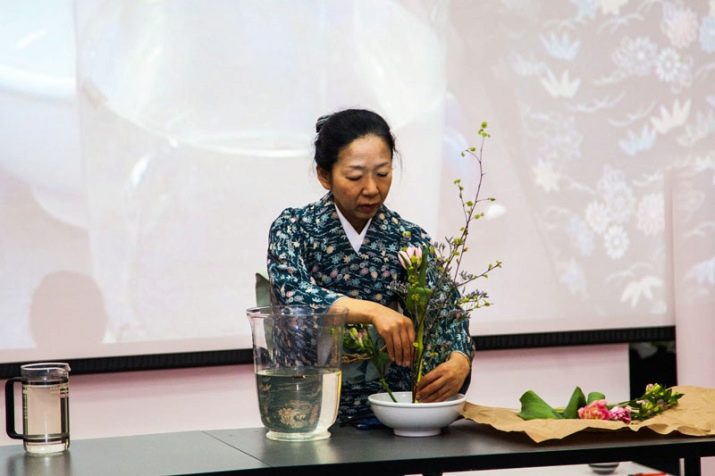
Views and styles
The philosophy of Buddhism, religion left a certain imprint on the main composition of ikebana, which was traditionally created from two branches - good and evil, then from three, when the image of a person joined them. This triangle will form the basis of all styles and types of ikebana. Contemporary art has undergone certain changes: the interior began to play a very important role, in which ikebana, the gamut of the surrounding color, and light are inscribed.
The Japanese are a very meticulous nation, they believe that drawing up ikebana is a practice similar to meditative, so you need to think over everything to the smallest detail.
Throughout the history of the art of "fresh flowers" hundreds of schools and different directions were born, but the most recognized and influential are few. Experts identify only three areas.
Ikenobo. This is the very first school that was formed in the 15th century by Ikenobo sensei. This monk composed unique compositions for temples: not too flashy, restrained, but incredibly meaningful in meaning. Their size, however, was very large. The main styles were seka and rikka.
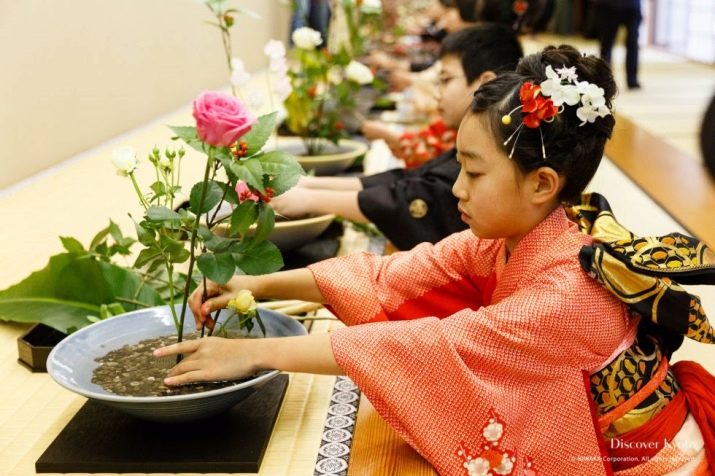
- Ohara. A later school, which was born in the 19th century and presented a new style that won love all over the world - Moriban. Its distinctive features are the use of low vessels, vases with water and a flat bottom.
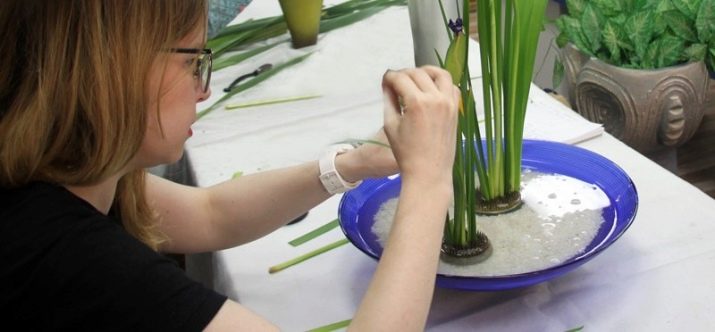
- Sogetsu. This "moon and grass" school was founded in the last century by Sophu Tesigahara. It was this master who first used third-party materials such as metal, plastic, and fabric in ikebana. Now the natural elements of the composition organically coexisted with the natural ones. Thanks to this, ikebana left the premises in parks, squares, city streets, subways.
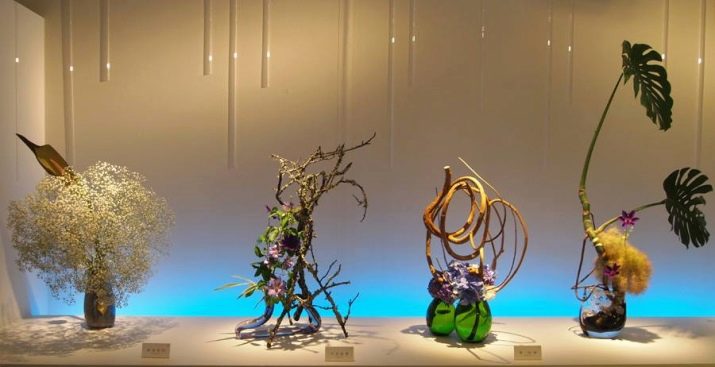
There are ikebana schools with different stylistic trends in many countries of the world, including Russia. This art came to our country rather late, in the 20th century. Most often, they teach not old methods, but modern styles.
Experts identify the following main styles in the art of "fresh flowers":
- nageire (heika), distinctive feature - arrangement of elements in high-type vases with support along the edges;
- moribana, hallmark - low-lying elements horizontally, flat vessels, trays are used;
- jiyuka - allows you to arrange elements in a free order and in any direction.
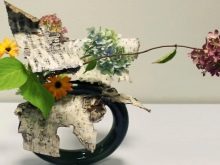
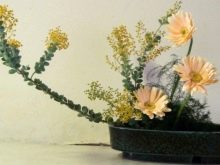
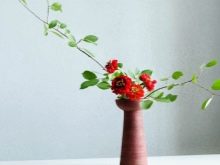
Let's take a closer look at each of the three main varieties.
Moribana
It is characterized by the following main features:
- tries to reflect the principles of naturalistic philosophy;
- differs in volumetric performance;
- only vessels of low type are used, but of different shapes: square, circle, rectangle, oval.
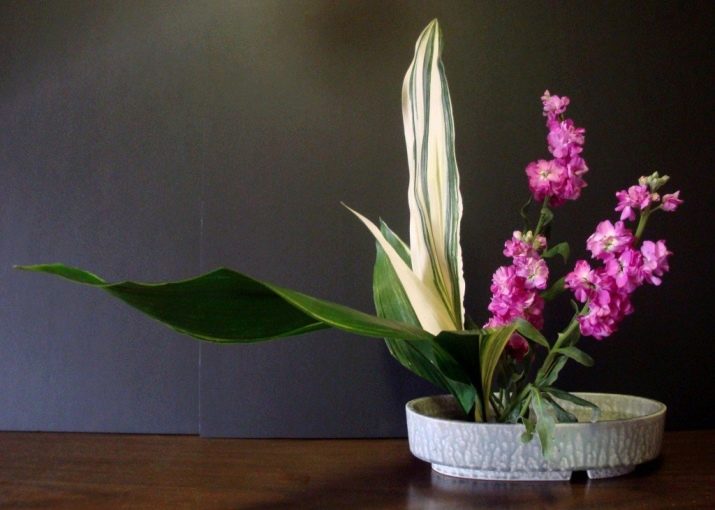
There are three components of the composition in this style, the proportional ratio of which must be strictly observed: Heaven, Man, Earth (7: 5: 3). It is important to rely on the size of the vessel, the order in which the elements are placed. The first action is the arrangement of the main objects on the rods, then they achieve volume, introducing additional elements that complete the plot.
There are three main forms of the Moribana style.
Tekutai - vertical, allowing the use of long, straightened elements, stems of plant flowers. Often these are bamboo, daffodils, gladioli. The base can be installed strictly vertically with a maximum deviation of 30 degrees to either side.
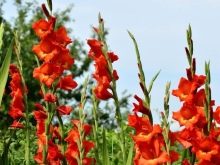


- Syatai - allows for inclination of shapes and transverse lines. Unusually curved materials, branches, are often used. Here the deviation is allowed more than in tekutai. It turns out the effect of a bent bouquet.

- Suitai - cascade location method. Plants of a flowing type are used here. The main elements of the composition can hang below the vessel. Look luxurious on stands, shelves.
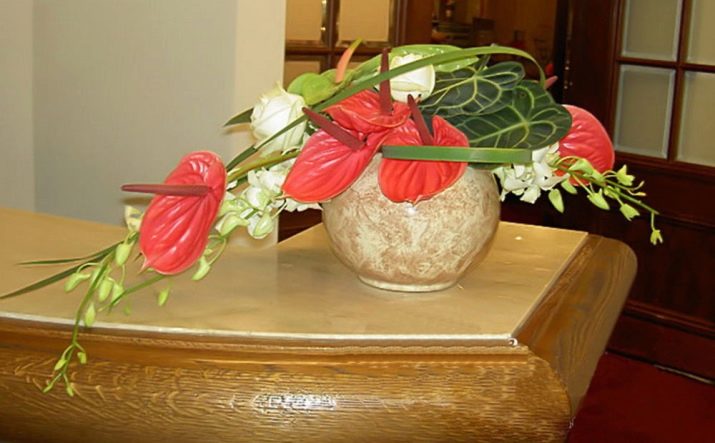
Nageire
The proportional relationship and the shape of the plot itself are similar to the previous style, here a fundamental difference is observed in the vases, more precisely, in their shape. Here, vessels of a high type with a narrowed throat are used, in which the ensemble is formed. Additional elements for fasteners are also used in the form of split-type branches, crosses, wood supports.
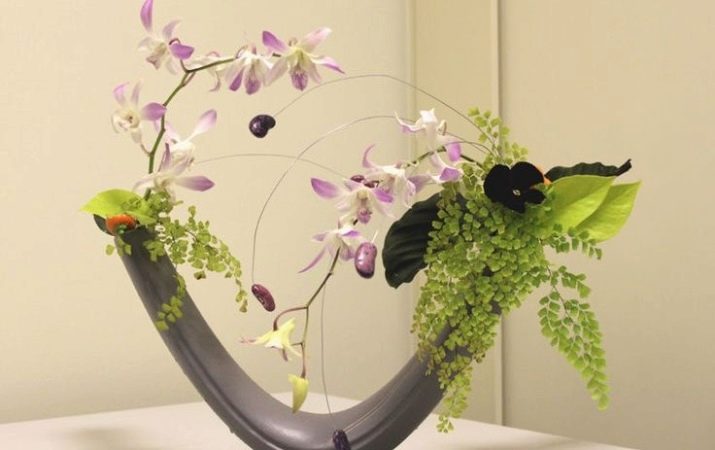
The main task of a composition in this style is to display the natural attractiveness of landscape motives, to demonstrate the spectacular bending of a flower, plant, branch.
Jiyuka
The freest of the varieties, in which non-trivial materials are used to enhance the beauty of natural ones. These ensembles are often surreal, eclectic. They combine ancient art and a new, modern view of the world. A variety of changes in shape are allowed, the inclusion of any materials, decorative elements, including artificial ones. A living flower, dead wood, plastic, metal, glass, stone can be combined in one ensemble.
The original vase is also preferable. Jiyuka allows eclecticism, mixing of directions, inclusion of geometric objects, expressive contrasts of color. The artist's imagination is not constrained by anything; he is free to create without limiting himself.


Basic principles of compilation
All the rules for composing ikebana are preceded by the basis - the idea of the composition, its idea and the main meaning. The Japanese devote a lot of time to this process, especially since it is largely meditative. The times when the ensemble could only be composed of a specialist monk are a thing of the past. But the very principle of treating ikebana, as an offering to the Universe, as a ritual procedure, has largely remained the same.
Each work should have a philosophical meaning. In traditional ikebana, this is the confrontation between the forces of evil and good, later, thanks to the development of the Chinese teachings of Confucius, a third element was added to the composition - a person. In addition to Confucianism, Zen teachings also contributed to the methods of composing ensembles, emphasizing the importance of being a person, the rejection of pomp in favor of the current moment and everyday life.
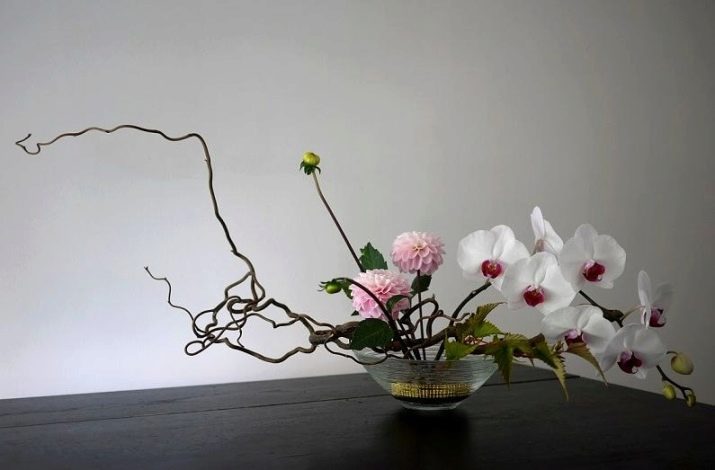
All this ultimately influenced the modern methods of composing, despite all the changes under the influence of time. In order to correctly compose a work, it is necessary to rely on three main components: Heaven, Earth, Man and additional elements that connect the whole ensemble into a harmonious whole. In addition, you must follow the rules for forming an ensemble:
- asymmetry is the basis for the placement of elements, but the overall composition is based on a triangle;
- despite the triangular base, all parts of the ensemble are not on the same line and in the same plane;
- Thinking over the proportions of the entire work, they primarily rely on the shape, height and size of the vessel;
- the choice of a vase is extremely important: it should not draw attention to itself, that is, be too flashy, it is better to choose a vase in one color that is in harmony with the overall composition;
- the vessel can be anything: a basket, a ladle, a toy, containers made of glass, wood, porcelain.

The most popular forms of containers for ikebana:
- flat type for moribana: plate, dish, tray of any shape;
- tall type, e.g. bottle, decanter.
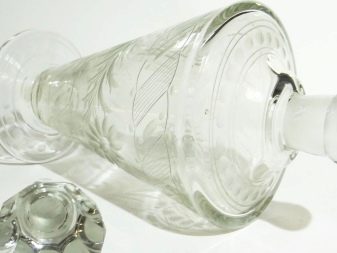

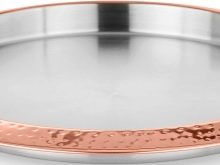
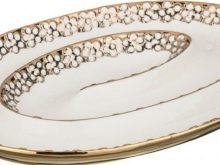
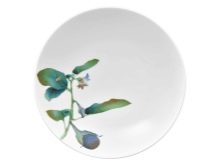
After the composition has been thought out and the vessel has been selected, they proceed to the selection of elements. It is very important here to correctly calculate the size, in this it is also worth starting from the size of the vase first of all. The chosen style also matters. There are different formulas for calculating the size of elements. To begin with, determine the length of Heaven, where the height and diameter of the vessel are added and multiplied by 1.5. Then determine the length of the Human line, which is? from Heaven.

An important point - the sizes of objects are considered without taking into account the part that is fixed inside the vessel.
The angle of inclination is important, it determines the shape of the entire ensemble. The Man's line should lean towards the Heaven line. The shortest item in the ensemble is Ground, placed in front of or away from the slope of the previous two lines... After the three main elements are located, additional jushi are included in the composition. The main thing is that they are not longer, catchy than the main ones, and do not stand out too intensely.
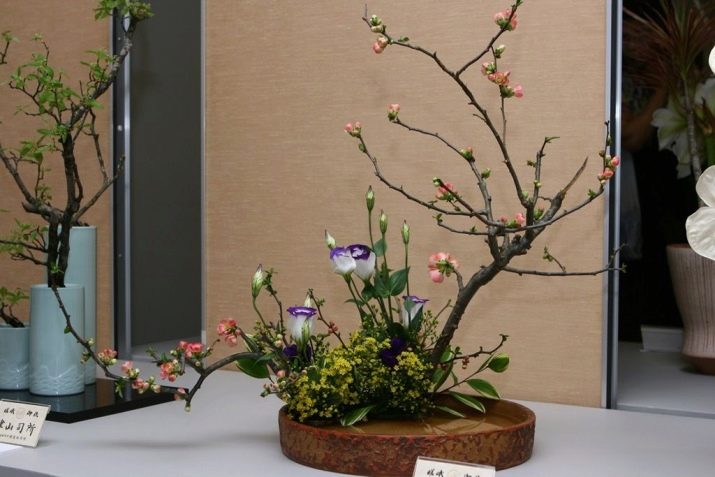
Bulky elements, too many different materials, excessive filling of the composition, splendor are not allowed in ikebana. The basic principle is a lot of free space, air, clarity and significance of each element. All details are fixed with kenzan or foam for florists, if the materials are artificial.
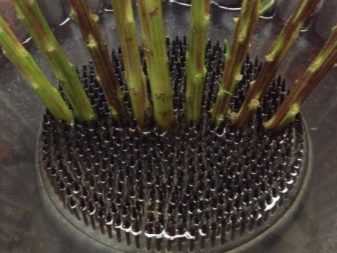
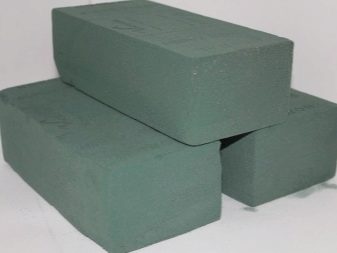
Even with clear rules, learning how to create in this way is quite difficult. Like any art, ikebana requires inspiration, learning, commitment, imagination. Experts recommend, first of all, to try simple ensembles and strict, unpretentious materials.
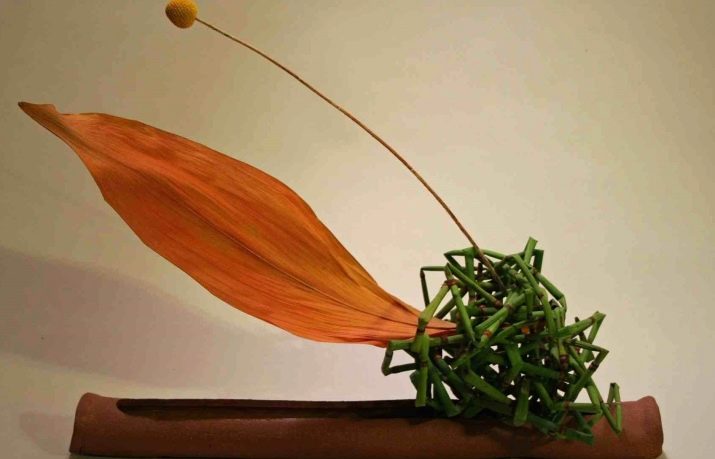
What can be made of?
Making ikebana with your own hands at home is a very exciting process. Moreover, this creative event involves the use of a variety of elements. Compositions made of natural material look very impressive: dried flowers, pine branches, branches of other trees, a Christmas tree, various leaves.Flowers are also popular: gladioli, orchids, daffodils. Parts made of foamiran and other materials are often used. In any case, the basis of the whole ensemble is the capacity.

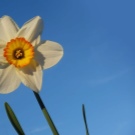
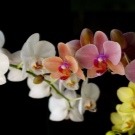
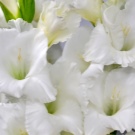
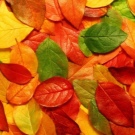
If you seriously decide to do ikebana, then consider purchasing a special stand in the base - kenzan. It is easily replaceable with sponges for florists, foam, sand, expanded clay. It is important to consider whether you plan to use natural or artificial materials. Depending on this, select fasteners. After the fixation is thought out, the vessel and materials are selected, you can begin to form a triangle.
remember, that elements should not be located in the same plane, the ensemble should be volumetric regardless of the material, asymmetric, multifaceted.
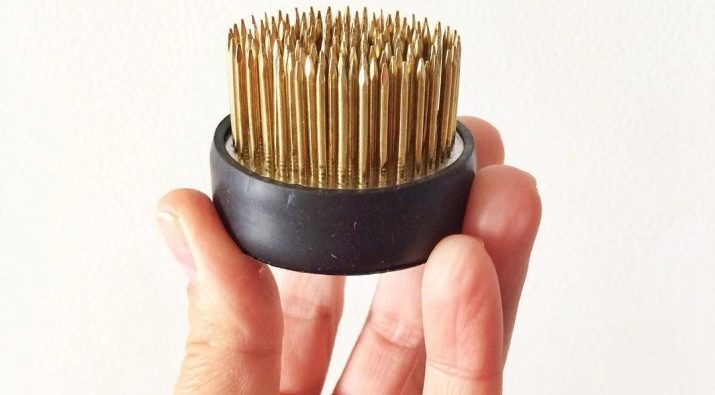
Large ikebanas can include several triangles, but before you start creating ensembles of such a complex structure, it is better to try to form a simple one.
Of flowers
To compose a composition of artificial or natural flowers, you need a vessel: a bowl, vase, saucer, bark, tray. Flowers are incredibly beautiful and perfect elements, so the vessel should not argue with it, rather, slightly emphasize all the beauty and fragility of the flower. When choosing a container, think over how it will overlap in color with the details of the ensemble. The ideal base for a modest floral piece is a faience basket or vase. If you prefer luxurious flowers such as chrysanthemums, lilies, roses, use more expressive vessels: glass vases, porcelain.
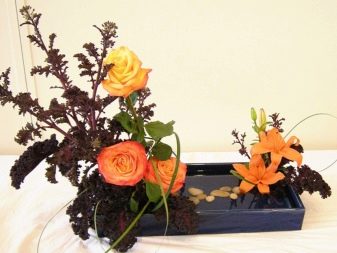
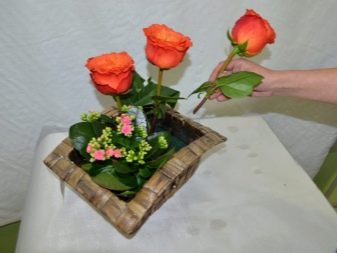
A solid colored vessel will best emphasize colorful floral elements. If you make the vase itself the center of the ensemble, and it should look more expressive, flowers of modest species and branches are taken as elements in this case. Artificial decor in contemporary ikebana style often becomes mainstream. Such flower arrangements are no less refined and graceful, while it is easy to care for them, but they will stand for a very long time, if you compare with a living flower.
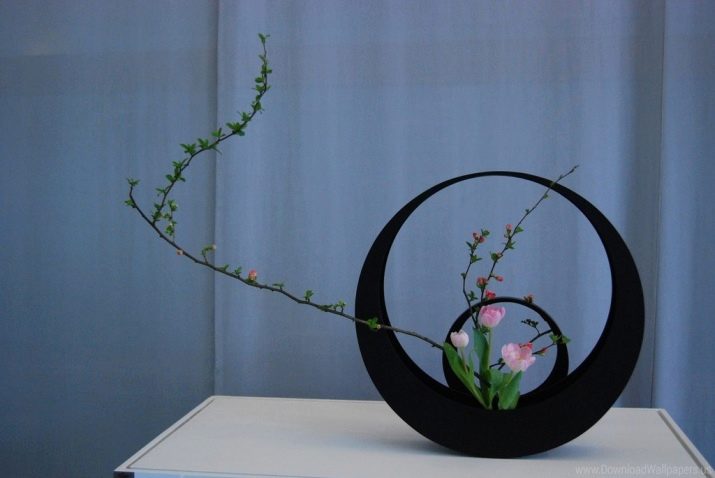
Roses are one of the most demanded flowers in ikebana, women are very fond of them, they amaze with their aesthetic noble appearance and stunning aroma, they stand for a long time.
A simple rose ikebana master class will require:
- capacity: vase, basket;
- the actual flowers and decor;
- florist sponge;
- pruner, knife, scissors.
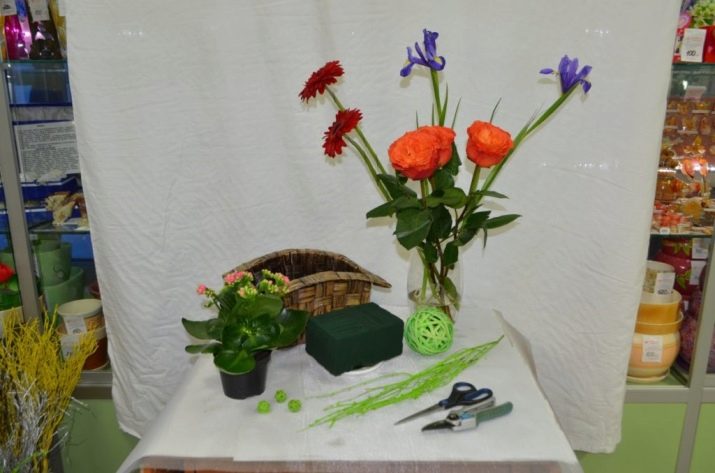
Algorithm:
- a sponge is laid out on the bottom of the vessel, which was previously moistened;
- a not too large plant is located in the center;
- cut the stems to the required size;
- we set flowers in a basket;
- fix;
- we add decor according to desire and concept, completing the overall picture.

From fruits and vegetables
Flowers are far from the only material for making flower arrangements. Ensembles of fruits and vegetables look unusual. Cauliflower is often used as an element. Parsley, dill, and other greens look great as a decor. Fruits are superbly complemented by bunches of berries, rowan branches. To make this ikebana look more interesting, it is better to choose the basis of a non-trivial form. In it, you can lay out the selected fruits or put them on skewers, adding additional decor.
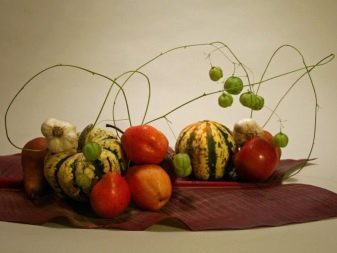
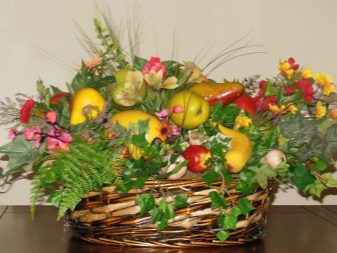
From dry twigs
Such compositions are very common in both minimalist and more elegant styles. Dry branches of the bare type are often taken to form futuristic ensembles. Spruce and pine branches are great for winter, festive products, intended as a gift for a celebration or as a home decoration. Coniferous branches are decorated with balls and other decor. Dry modest branches are perfectly complemented by flowers.
We offer you a master class on creating an elegant composition from dry branches and dahlias. You can use decorative or real branches with berries, hawthorn branches, mountain ash.

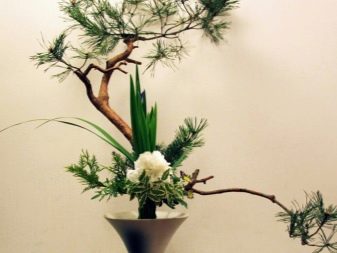
Feel free to get creative and take a good look at your garden plot.
Work algorithm:
- the selected branches are located in the container;
- in the process of placing, the branches are pruned, get rid of unnecessary parts;
- the central area is decorated with greenery and selected branches;
- since the composition contains fresh flowers, it is necessary to pour water into the vase;
- choose dahlias of different sizes and heights, include them in the ensemble;
- finish the composition by editing the elements.
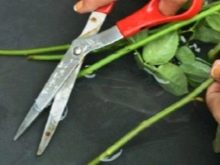
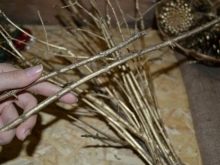
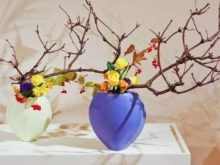
Subject
It is very important to put into the ensemble the mood that dominates you, your worldview. Often it can be an event or just the embodiment of the weather outside the window. The seasons bring certain motives to ikebana. Very often they are made up for some moment, holiday, as a gift or for yourself. New Year, winter, and Christmas themes are often used in ikebana, as well as in autumn.
Spring ensembles for March 8 are very popular or simply as the personification of the awakening of nature from sleep.
Spring mood is embodied mainly with flowers: tulips, hyacinths, daffodils, freesias and fruit tree branches. First of all, decide which of the inflorescences will play the main role, and which will play a secondary role, the whole ensemble is built around this.
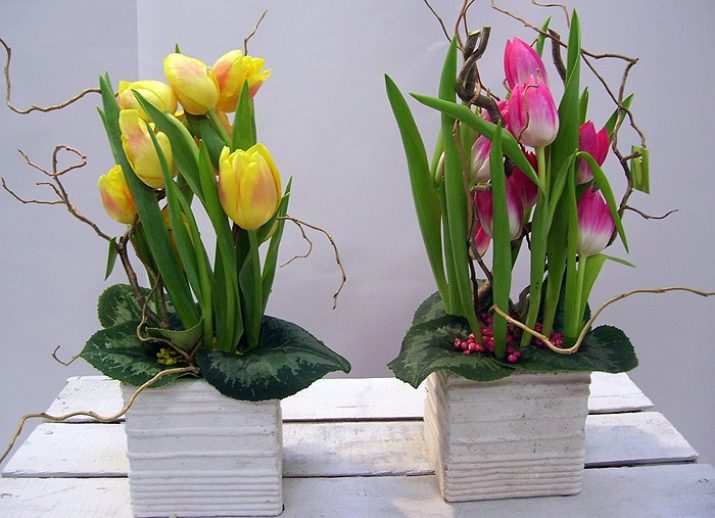
Algorithm of creation:
- we prepare all the elements and tools;
- we prepare the material according to the dimensions of the vessel;
- we moisten the fixative, place it in the container;
- pour in water until the sponge is covered;
- remove extra leaves from flowers, cut the stems;
- we place more expressive flowers in the center;
- then randomly add minor flowering plants;
- we make out branches of fruit trees;
- we place small flowers at the edges, emphasizing the size and expressiveness of the central ones;
- we fix all the plants, give them the right direction.
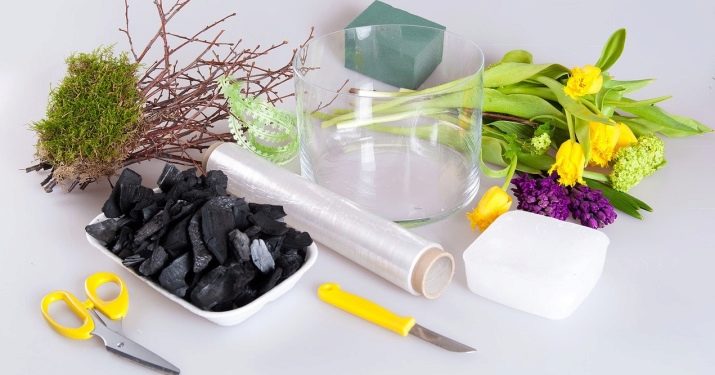
Autumn motives are very multifaceted, they are bright, juicy and effective, while the mood of wilting nature can be both basic and half-hint. A bright branch with beautiful autumn leaves combined with matching flowers is enough to create a graceful ensemble. Fantasy is not held back by anything here.
We offer an algorithm for creating an autumn motive:
- on the bottom of the vessel there is a retainer with spikes; it is purchased in florist shops;
- branches of an autumn tree, for example, a fruit tree, are thinned out;
- give them the necessary direction and shape;
- fix in a container;
- trim the stem of the selected flower, for example, rose, chrysanthemum;
- free them from excess foliage;
- place flowers at different heights, for example, a rose above, a chrysanthemum below;
- add decor, straighten the ensemble.

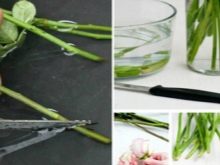
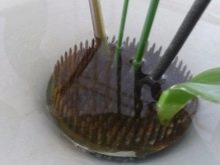
Beautiful examples in the interior
We bring to your attention several beautiful compositions that you can create with your own hands and decorate the interior.
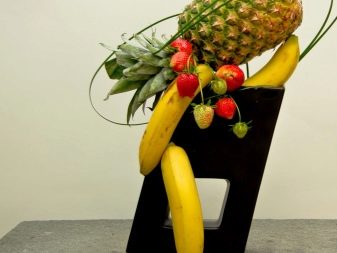
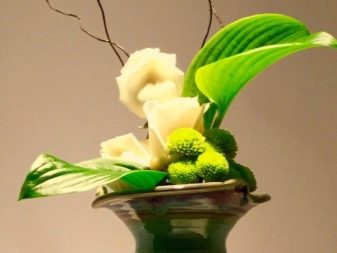

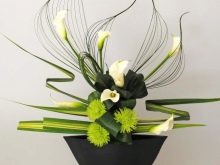
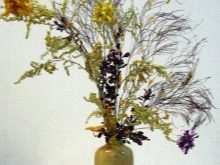
For information on how to make paper flower arrangements, see the video below.








